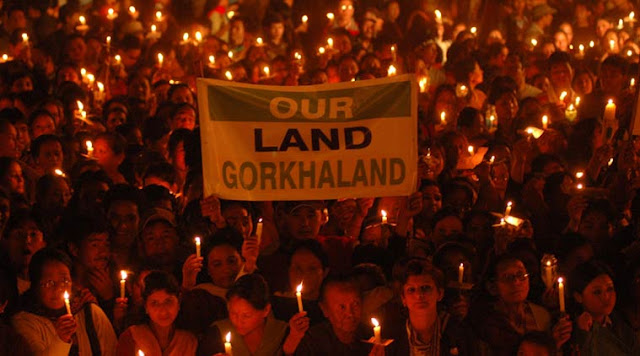Writes Premankur Biswas
April 23, 2016 Earlier this week, when the State Bank of India included Nepali in the revised list of official languages for its recruitment procedure in West Bengal, the Gorkhaland movement in North Bengal received boost of sorts.
Since 1907, the Gorkhas of north Bengal have demanded a separate administrative unit in Darjeeling, and the Nepali language has played an important role in the scheme of things. Even in this year’s Assembly Election, Gorkha Janmukti Morcha, the most prominent party of the area, has actively campaigned on this very issue.
In 1917, in a petition of the Hillmen’s Association to Edwin Montague (the then secretary of state for India) it was stated that “Darjeeling’s inclusion in Bengal was comparatively recent and only because the British were rulers common to both places. …Historically, culturally, ethnically, socially, religiously and linguistically there was no affinity whatsoever between Bengal and Darjeeling.”
According to Michael Hutt’s seminal book on the Nepali Diaspora— Being Nepali without Nepal: Reflections on a South Asian Diaspora, in the 1951 census the then District Census Officer A. Mitra, (ICS) stated that only 19.96% of the population (numbering a total population 88,958) in Darjeeling district spoke Nepali. He did this by presenting only Kami, Damai, Chettri , Brahmin, and Sarki as Nepali speaking– while the rest of the hill populace Limbu, Gurung, Rai, Mangar, Sherpa, Newar, Lepcha and others whose lingua franca was also Nepali were counted as separate entities on the grounds of having their own dialects. According to Hutt, the total Nepali speaking population in Darjeeling District at that time was 66% (2.90 lakhs). Based on this manipulated data, Nepali was not included as the national languages of India.
Finally in 1961, Nepali was recognized as an official language of West Bengal, and in 1992, Nepali was recognized as one of the Official Languages of India under the VIIIth Scheduled of Indian Constitution.
However, till date Nepali is not offered as an optional subject in the West Bengal Civil Services Examination.
However, in 2011, right after coming to power, CM Mamata Banerjee had included Nepali as one of the six “second official” languages of the state. She also included Nepali as one of the languages for answering question papers in the examinations by the Public Service Commission in February this year. However, The Darjeeling Chronicle, an online civil society forum, which has been actively campaigning for the inclusion of Nepali language as an optional language in the WBCS examination, says that it’s not same thing. “To be able to answer the questions in Nepali is not the same thing as having Nepali as an optional paper,” said Upendra Pradhan, activist from the Darjeeling Chronicle.
Via indianexpress
April 23, 2016 Earlier this week, when the State Bank of India included Nepali in the revised list of official languages for its recruitment procedure in West Bengal, the Gorkhaland movement in North Bengal received boost of sorts.
Since 1907, the Gorkhas of north Bengal have demanded a separate administrative unit in Darjeeling, and the Nepali language has played an important role in the scheme of things. Even in this year’s Assembly Election, Gorkha Janmukti Morcha, the most prominent party of the area, has actively campaigned on this very issue.
In 1917, in a petition of the Hillmen’s Association to Edwin Montague (the then secretary of state for India) it was stated that “Darjeeling’s inclusion in Bengal was comparatively recent and only because the British were rulers common to both places. …Historically, culturally, ethnically, socially, religiously and linguistically there was no affinity whatsoever between Bengal and Darjeeling.”
 |
| Nepali was recognized as an official language of West Bengal in 1961, and in 1992 was recognized as one of the Official Languages of India under the VIIIth Scheduled of Indian Constitution |
Finally in 1961, Nepali was recognized as an official language of West Bengal, and in 1992, Nepali was recognized as one of the Official Languages of India under the VIIIth Scheduled of Indian Constitution.
However, till date Nepali is not offered as an optional subject in the West Bengal Civil Services Examination.
However, in 2011, right after coming to power, CM Mamata Banerjee had included Nepali as one of the six “second official” languages of the state. She also included Nepali as one of the languages for answering question papers in the examinations by the Public Service Commission in February this year. However, The Darjeeling Chronicle, an online civil society forum, which has been actively campaigning for the inclusion of Nepali language as an optional language in the WBCS examination, says that it’s not same thing. “To be able to answer the questions in Nepali is not the same thing as having Nepali as an optional paper,” said Upendra Pradhan, activist from the Darjeeling Chronicle.
Via indianexpress


.jpg)



Post a Comment